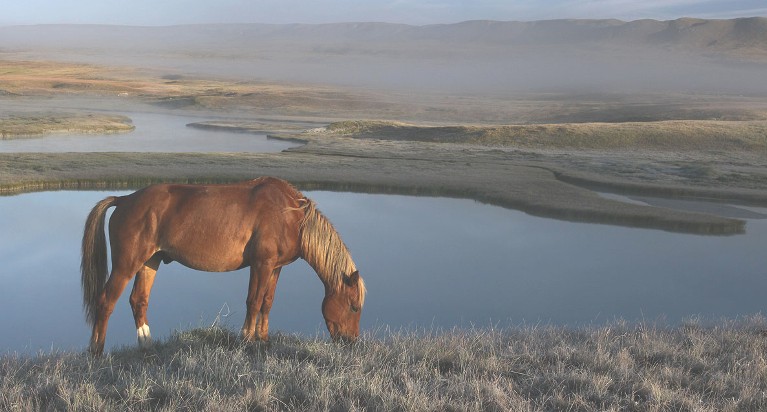
The Arian Invasion
This subject IS controversial; Hindus themselves say that the Arian's were immigrants NOT conquers. However, There can be no doubt that:
1) Indians ARE a mix of indigenous people and the Albinos – in very varying degrees (excepting Dravidians).
 |  |  |  |  |
2) The Rig Veda, which is one of the earliest known writings written in any Indo-European language, The Hindu Bible of sorts. The Rig Veda speaks explicitly of war with, and conquest of Blacks.
Here are some excerpts from the Rig Veda.
The Arian words for the original people were {Dasyus, Dasas and Simyus}.
It should be kept in mind, that the Veda's were written several centuries after the fact. As is always the case with oral histories, myth and fact become blended over time and then become indistinguishable, one from the other.
a) He, much invoked, hath slain Dasyus and Simyus, after his wont, and laid them low with arrows.
The mighty Thunderer with his fair-complexioned friends won the land, the sunlight, and the waters.
b) Sing, with oblation, praise to him who maketh glad, who with Rjisvan drove the dusky brood away.
c) Indra in battles help his Arian worshipper, he who hath hundred helps at hand in every fray, in frays that win the light of heaven.
Plaguing the lawless he gave up to Manu's seed the dusky skin; Blazing, 'twere, he burns each covetous man away, he burns, the tyrannous away.
d) Strengthened by songs of praise thou rentest piecemeal the Dasa, him who deemed himself immortal. With us mayst thou, O Indra, waxen splendid, with Surya overcome the Dasa races.
e) Indra the Vrtra-slayer, Fort-destroyer, scattered the Dasa hosts who dwelt in darkness. {Prof. Uthaya Naidu translates this as "who sprang from a black womb."}
f) When in his arms they laid the bolt, he slaughtered the Dasyus and cast down their forts of iron.
g) His kine their Lord hath shown, e'en Vrtra's slayer, through the black
hosts he passed with red attendants.
h) Active and bright have they come forth, impetuous in speed like bulls,
Driving the black skin far away.
i) Blowing away with supernatural might from earth and from the heavens the swarthy skin which Indra hates.
3) There is no other way to account for The Hindu Caste system, except as something put in place by an invader, who upon conquering an indomitable foe, and seeking to insure that he does not rise again, codifies his status with religious dogma and social taboo's.
The Albino advance, interaction with the Black People
The Aryans/Arians came to the Indus Plain on horseback, in waves separated perhaps by decades or longer. Like other pastoral people, they were warriors, the Arian's were familiar with prowling and hunting and with bow and arrow. Each family was ruled by an authoritarian male, and each Arian tribe was ruled by a king called a raja, who was obliged to consult with tribal councils, on matters of major importance.
Like other pastoral people, the Arian invaders were storytellers. They brought with them their centuries old sacred hymns, myths and oral history - stories that expressed their desire to please their gods. They had a father god of the heaven, sky and atmosphere: called Dyaus Pitar (sky father). They had a male god of thunder and rain called Indra, who was also the god of war.
The Arians had a god of fire they called Agni. To the Arian's, Agni "was" fire, and they believed that Agni hungrily devoured the animals that they sacrificed in their rituals of burning. These sacrifices were performed by priests to obtain from their gods the gifts of children, success in war, wealth, health, longevity, food, drink or anything else that contributed to their happiness.
With the passing years, the waves of Arian tribes that had come to the Indus Plain, spread out across the region. They warred against the ancient original people, and they took and settled their land. This land then provided the Arians with pasture for their animals. The Arians grouped in villages and built homes of bamboo or light wood - homes without statues or art. They soon learned agriculture and began growing crops. The environment supplied them with all they needed. But perhaps responding to their old traditions and impulses, the Arian tribes began warring against each other - wars that might begin with the stealing of cattle.
Because of these wars, gradually Arian tribal kings began changing from elected leaders to autocratic rulers. Arian kings had begun associating their power with the powers of their gods, rather than the approval of their fellow tribesmen. They began allying themselves with priests. And as in the West, kings were acquiring divinity. By taxing their subjects, these kings could then create armies that were theirs, rather than an instrument of the tribe.
In the decades around 1,000 B.C, there was a shortage of rainfall in the Indus valley, and running from this drought, some Arian tribes trekked eastward along the foot of the Himalayan mountains. Here the jungles were less dense, and the rivers easier to cross, this path took them to the plains of the Ganges Valley. Meanwhile some Arian priests had wandered ahead of their tribes, in order to evangelize among the tribes that they may come upon. They found these societies to have a more egalitarian organization than they had, and so they despised them for not having kings as godly and autocratic as theirs.
By now, the Arian's had acquired iron tools and weapons, iron having spread eastward through Persia. And now with their superior weaponry, the Arian's fought those who resisted their advance. The Arian's believed that the gods were on their side, and that resistance from local peoples was inspired by demons. Gradually the Arian's spread out over much of the Ganges Valley.
Some Arian's also migrated south, along the western coast of the Indian subcontinent, and some Arian's went down the eastern coast, to an area called Kalinga. A few Arian's went as far south as the island that in Hindu literature, was called Lanka. And some Arian priests went as missionaries to southern India. Occasionally the Arian missionaries might feel threatened or mistreated, and they would then seek the aide of their king. This being a good pretext for incursions, their king's warriors would came south to their rescue. Incursions not withstanding, Southern India remained independent of Arian rule.
Dravidian People of Southern India
 |  | 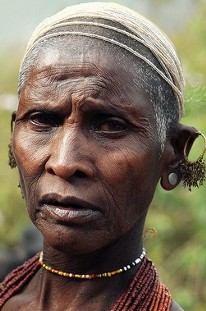 |  |  |
With the Arian's settling alongside local peoples, a complex hierarchy of classes developed that would be called caste. At the top of this class ranking was the priests and their entire families, the Brahmins. Also at the top were the warrior-aristocrats, the Kshatriyas, whose job it was to practice constantly for combat. Neither the Brahmins nor the Kshatriyas conceded superiority to the other, but they agreed that the other classes were lower than they. The first of these lower classes was the Vaishas and their families. This class were Arian's who tended cattle and served the Brahmins and Kshatriyas in others ways (the middle-class). The lowest class was the conquered Blacks, they were called the Shudras. The Arian's made these four classifications a part of their mythology. The four groups it was claimed, came from the body of the god Prajapati: the Brahmins from the god's mouth, the warriors from the god's arms, the tenders of cattle from his legs, and the Shudras from his feet.
Dravidian People of Southern India
 |  |  |  |  |
In the beginning this class system was less rigid than it would be centuries later. People from different classes could dine together. A man from a non-Brahmin family could still become a priest and therefore a Brahmin. And although marriage within one's own class was preferred, there was no absolute restriction against marrying people from a different class.
By around 700 or 600 B.C, the migrations of the Arian's had ended. With their new successes in agriculture, the Arian's increased in number and they began to create cities. Arian traders, merchants, and landlords appeared, as did money lending. Arian's began trading with Arabia and the great empire of the Assyrians. In the 600s B.C, India began trading with China, the Malay Peninsula and the islands of what is now, Indonesia and the Philippines. By 600 B.C, numerous cities had arisen in northern India - cities with fortifications, moats and ramparts in response to the dangers of war. In northern India, along the Ganges River, sixteen different kingdoms had emerged.
Over time, a mix developed between the nomadic religion of the Arian's, and the local religions of the conquered. This mix came with Arian males marrying non-Arian females, and it came with some among the conquered, accepting the religion of their conquerors - much as Amerindians in the Americas, accepted the religion of their Christian conquerors.
Mixed Race Hindus
 |  |  |  |  |
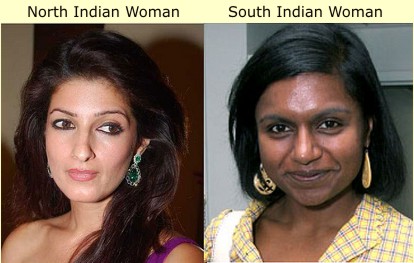 |  |
 | 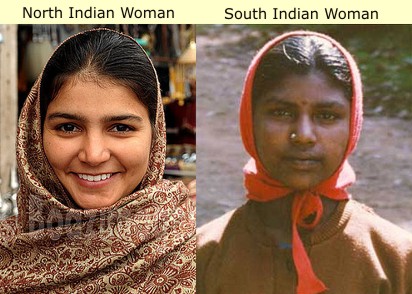 |
Hinduism
In India this blend of Arian and local religions became known as Hinduism, a word derived from the Arian word Sindu, the name the Arian's gave to the Indus River. The Hindu religion ranged from veneration of traditional Arian gods, by urban intellectuals, to the worship of a diversity of local, rural, and agricultural deities.
Generally; Hinduism is the conviction that the soul or self (atman) is subject to “samsara” the transmigration through many forms of incarnation. Held together with this belief is another, that of “karman” which says that the soul carries with it, the burden of its past actions; which conditions the forms of its future incarnations. As long as the soul mistakes this phenomenal world for reality and clings to existence in it, it is doomed to suffer endless births and deaths.
The various Indian cults and philosophical systems offer ways in which to attain moksa or mukti (release or liberation) from the misery of subjection to the inexorable processes of cosmic time. Basically, this liberation consists of the soul's effective comprehension of its essential unity with Brahman, the supreme “Atman” or essence of reality, and it’s merging with it. Most of the ways by which this goal may be attained require self-effort in mastering meditation techniques and living an ascetic life. But, in the devotional (bhakti) cults associated with Visnu (Vishnu) and Siva (Shiva), an intense personal devotion to the deity concerned is believed to earn divine aid to salvation. Also see Jainism – next Indus page. |  |  |
 |  |  |
Vishnu
Vishnu is one of the principal Hindu deities, worshiped as the protector and preserver of the world and restorer of dharma (moral order). Vishnu, like Siva (the other major god of Hinduism), is a syncretic personality who combines many lesser cult figures and local heroes.Temple images of Vishnu depict him either sitting, often in the company of his consorts Laksmi (also called Sri) and Bhumidevi (Earth); standing holding various weapons; or reclining on the coils of the serpent Sesa, asleep on the cosmic ocean during the period between the periodic annihilation and renewal of the world. The standing Vishnu is dressed in royal garments and holds in his four (sometimes two) hands the sankha (conch), cakra (discus), gada (club), or padma (lotus). On his chest is the curl of hair known as the srivatsa mark, a sign of his immortality, and around his neck he wears the auspicious jewel Kaustubha. In painting, Vishnu is usually shown as dark complexioned, which is also a distinguishing feature of his incarnations.
 | 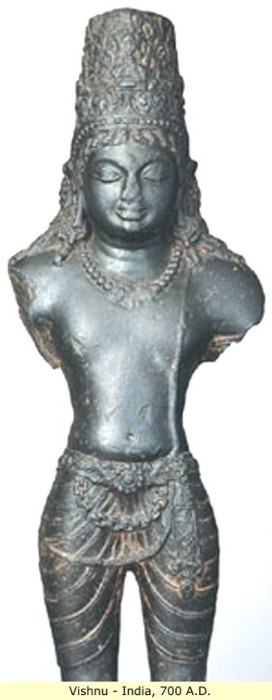 | 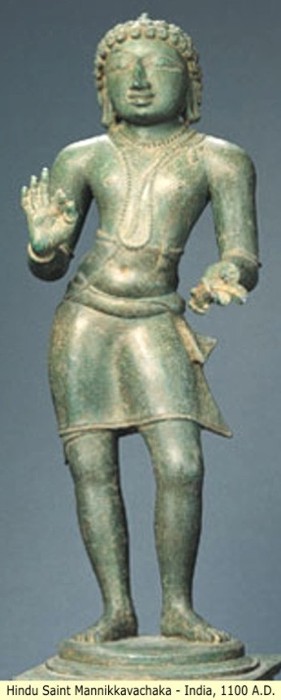 |
 |  |  |
Siva
Also spelled Siwa, or Shiva, one of the main deities of Hinduism, worshiped as the paramount lord by the Saiva (Shaivite) sects of India. Siva (Sanskrit: “Auspicious One”) is one of the most complex gods of India, embodying seemingly contradictory qualities. He is both the destroyer and the restorer, the great ascetic and the symbol of sensuality, the benevolent herdsman of souls and the wrathful avenger. Though some of the combinations of roles may be explained by Siva's identification with earlier mythological figures, they also arise from a tendency in Hinduism to combine complementary qualities in a single ambiguous figure.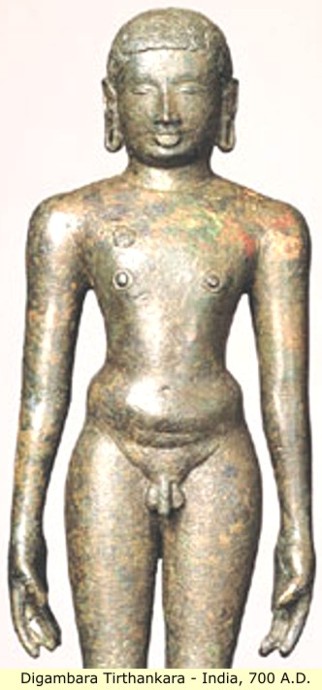 | 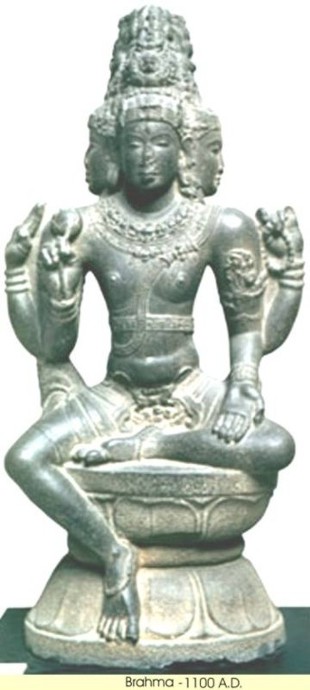 |  |
Siva is usually depicted in painting and sculpture as white or ash-colored, with a blue neck (from holding in his throat the poison thrown up at the churning of the cosmic ocean, which threatened to destroy humankind), his hair arranged in a coil of matted locks (jatamakuta) and adorned with the crescent moon and the Ganges (according to legend he brought the Ganges River to earth by allowing her to trickle through his hair, thus breaking her fall). He has three eyes, the third eye bestowing inward vision but capable of burning destruction when focused outward. He wears a garland of skulls and a serpent around his neck and carries in his two (sometimes four) hands a deerskin, a trident, a small hand drum, or a club with a skull at the end.
 |  |
| It can logically be deduced; that having two co-equal supreme gods “Vishnu and Siva” one Black, one White; was an attempt by the Arians to encourage acceptance of the new Hindu religion, by the ingenious people. |
Siva is represented in a variety of forms: in a pacific mood with his consort Parvati and son Skanda, as the cosmic dancer (Nataraja), as a naked ascetic, as a mendicant beggar, as a yogin, and as the androgynous union of Siva and his consort in one body, half-male and half-female (Ardhanarisvara). Among his common epithets are Sambhu (“Benignant”), Sankara (“Beneficent”), Pasupati (“Lord of Beasts“), Mahesa (“Great Lord”), and Mahadeva (“Great God”).
Siva's female consort is known under various manifestations as Uma, Sati, Parvati, Durga, and Kali (Siva is also sometimes paired with the supreme goddess, Sakti). The divine couple, together with their sons—the six-headed Skanda and the elephant-headed Ganesa—are said to dwell on Mount Kailasa in the Himalayas. Siva's mount and animal image is the bull Nandi; a sculpture of Nandi sits opposite the main sanctuary of every Siva temple. In temples and in private shrines Siva is worshiped in his fundamental form of the linga, or phallus.
No comments:
Post a Comment